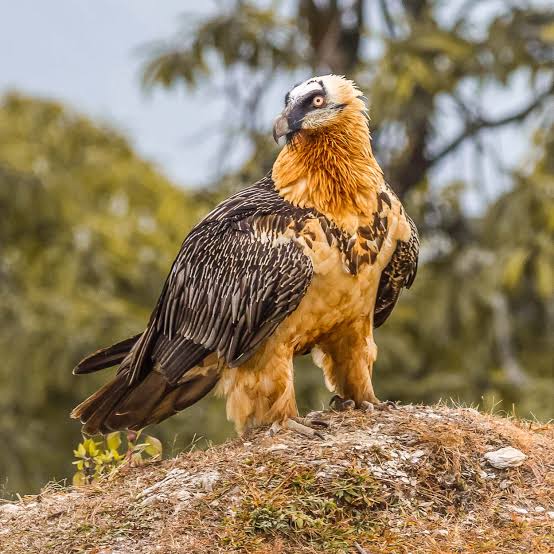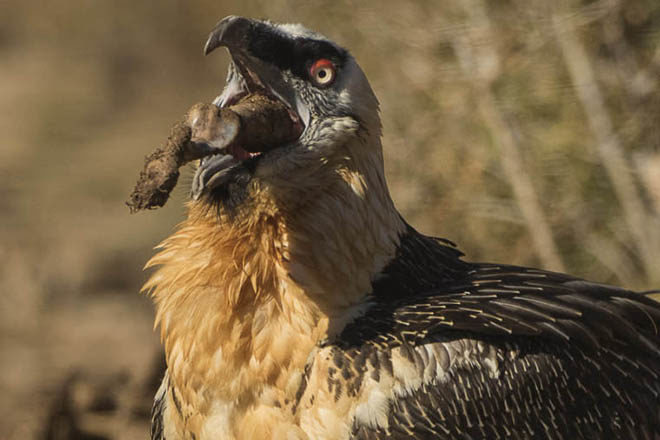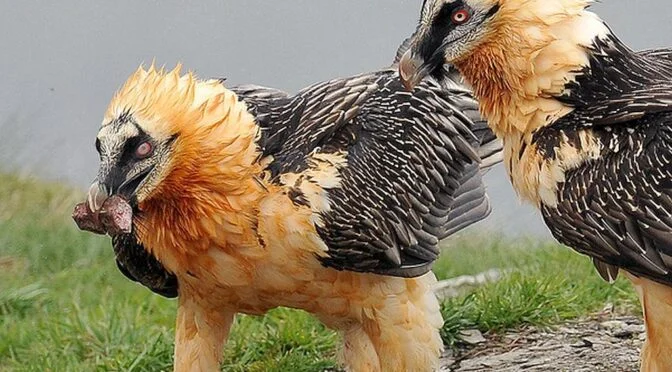The bearded vulture (Gypaetus barbatus), also known as the lammergeier and ossifrage, is one of the most fascinating raptors in the world. Its distinct appearance, ecological importance, and unique behaviors make it a species worth studying in-depth. Explore the classification, physical characteristics, distribution, habitat, foraging strategy, migration patterns, and conservation status of the Bearded Vulture.
Kingdom: Animalia
Phylum: Chordata
Class: Aves
Order: Accipitriformes
Family: Accipitridae
Genus: Gypaetus
Species: Gypaetus barbatus
The bearded vulture is a member of the family Accipitridae, which includes other raptors like eagles, hawks, and kites. Within this family, it stands out due to its unique feeding habits, primarily consuming bones. It belongs to the genus Gypaetus, and the species name barbatus refers to its distinct beard-like feather tufts under the beak.
The bearded vulture is easily identifiable by its striking appearance. It features a reddish-brown plumage with dark wings and tail, which become more vibrant during the breeding season. Its most notable feature is its long black "beard" beneath its beak, which is a tuft of feathers that gives it its name. This raptor has an impressive wingspan ranging from 2.6 to 2.8 meters (8.5 to 9.2 feet), making it one of the largest vultures in the world.

The bearded vulture is relatively large, with an average body length of about 95 to 125 cm (37 to 49 inches). Its weight typically ranges between 4.5 and 7.5 kg (10 to 17 pounds), with females usually being slightly larger than males.
Wild bearded vultures have an average lifespan of 21.4 years, but some have been known to live up to 45 years in captivity. The bearded vulture is currently listed as Near Threatened on the IUCN Red List due to population declines driven by factors such as habitat loss, poisoning, and human-wildlife conflict. Efforts are underway to protect the species through reintroduction programs, habitat restoration, and legal protections in several countries.
The bearded vulture is found primarily in mountainous regions of Europe, Africa, and Asia, particularly in the Alps, Pyrenees, Himalayas, and Tian Shan mountains. It prefers high-altitude cliffs, where it can build its nest on rocky outcrops and easily access its food sources.
Europe: The bearded vulture is present in the Alps, Pyrenees, and Balkan Mountains.
Asia: The species is also found in the Himalayas, Tian Shan, and Altai Mountains.
Africa: Small populations can be found in North Africa, particularly in Morocco and Algeria.
The bearded vulture has a unique and highly specialized feeding behavior. Unlike other vultures that primarily feed on decaying flesh, the bearded vulture specializes in eating bones. It has incredibly strong digestive acids that can break down bone matter, allowing it to extract nutrients such as calcium. The vulture is known to drop large bones from high altitudes to break them open, making it one of the few animals that actively use tools in its feeding strategy.
Bearded vultures are monogamous and tend to mate for life. They are generally solitary or found in pairs, except during the breeding season when they may be seen in small groups. While they are not as social as some other bird species, their interactions during the breeding season are vital for reproductive success.
While the bearded vulture is not a long-distance migratory bird like some species, it does exhibit altitudinal migration. In winter, it may move to lower altitudes to seek more favorable conditions, such as food and milder temperatures, before returning to its breeding grounds in the higher mountains during the warmer months.
The bearded vulture (Gypaetus barbatus) is a very large bird of prey in the monotypic genus Gypaetus, which means it is the sole species within its genus. This remarkable vulture is particularly distinctive for its unusual diet, consisting of 70–90% bone. This makes it the only known vertebrate species whose primary food source is bone.
Bearded vultures have a specialized feeding behavior that sets them apart from other scavengers. Instead of feeding primarily on flesh, like most other vultures, they target bone marrow, a rich source of nutrients. To access the marrow, bearded vultures will drop large bones from great heights onto rocks below to break them open. Once the bone is shattered, the vulture consumes the marrow and any remaining bone fragments. This bone-heavy diet is made possible by their incredibly strong digestive acids, which can break down even dense bones.
This unique diet and feeding behavior make the bearded vulture an exceptional species within the avian world. Its reliance on bones rather than flesh means that it plays a key ecological role in cleaning up bones in the environment, aiding in the recycling of minerals like calcium back into the ecosystem.
Foraging: The bearded vulture spends a significant amount of time soaring over cliffs and ridges in search of bone material, often covering great distances.
Nesting: These birds are known to build their nests in remote, high cliffs, which are often difficult for predators to access. The nesting season typically spans from December to May, with the female laying one or two eggs.
The bearded vulture’s feeding strategy is remarkable due to its focus on bones. It can consume bones from small mammals and birds, and it has been observed feeding on carcasses left behind by other predators. It plays a crucial role in cleaning up animal remains in mountainous ecosystems. By feeding on bones, it helps recycle calcium and other essential minerals back into the ecosystem.
The bearded vulture (Gypaetus barbatus) has one of the most specialized and powerful digestive systems in the animal kingdom. The acid concentration in its stomach has been estimated to have a pH of around 1, making it highly acidic. This acidic environment is crucial for the bird’s ability to digest its bone-heavy diet, which consists largely of bone marrow.
The digestion of large bones typically takes about 24 hours. This is facilitated by the slow, rhythmic mixing or churning of the stomach contents, allowing the acids to break down the bones gradually. The high fat content in the bone marrow makes it particularly energy-rich, and the bearded vulture derives nearly as much net energy from bone as it would from muscle tissue, despite the bone being less completely digested. This specialized adaptation allows the bird to survive on a diet that would be difficult for other scavengers to process.
Moreover, bones left on mountain slopes tend to dehydrate, which protects them from bacterial degradation, meaning they remain intact for much longer. This unique trait is beneficial to the bearded vulture, as it can return to consuming the remainder of a carcass, even months later, after the soft tissues have already been eaten by other animals, larvae, or decayed through bacterial processes. This allows the bearded vulture to scavenge in a more sustained way, enabling it to make use of food sources long after other creatures have finished with them.
In this way, the bearded vulture’s digestive system is perfectly adapted to its ecological niche, providing it with the ability to consume and make use of bones and other resources that would otherwise go to waste, contributing to its role as an important scavenger in its environment.

The bearded vulture (Gypaetus barbatus) has one of the most unique diets in the bird world. As a scavenger, this bird feeds mostly on the remains of dead animals, with a preference for bones. Its diet consists of mammals (93%), birds (6%), and reptiles (1%), with medium-sized ungulates (hoofed animals) making up a significant portion of its diet. Interestingly, unlike most scavengers, the bearded vulture does not prioritize meat or soft tissues but primarily feeds on bones and bone marrow, making up about 85–90% of its diet.
The bearded vulture is the only known bird species that specializes in feeding on bones. This is facilitated by its powerful digestive system, which can dissolve even large bone pieces. The high-fat content of bone marrow is especially nutritious, making bones a highly valuable food source for the vulture. The preferred bones are fattier and elongated, such as tarsal bones and tibias, which are rich in oleic acid, an essential fatty acid. Smaller bones, on the other hand, are less nutritious because they contain less marrow and are harder to digest.
One of the most fascinating behaviors of the bearded vulture is its bone-cracking technique. When faced with bones too large to swallow, the bird takes them to great heights, typically 50–150 meters (160–490 feet) above the ground. It then drops the bones onto rocks, breaking them into smaller, digestible pieces and exposing the marrow inside. The bearded vulture can carry bones up to 10 cm (3.9 inches) in diameter and weighing more than 4 kg (8.8 lb), almost the same weight as the bird itself. After dropping the bones, the vulture spirals down to inspect them and may repeat the process if the bone is not sufficiently cracked.
This behavior, often called the bone-breaking habit, requires significant practice, and immature birds take up to seven years to master it. The name "ossifrage" (meaning "bone breaker") is derived from this skill. In rare cases, bearded vultures may also hammer bones into rocks while perched to break them into smaller pieces.
In addition to scavenging, bearded vultures also hunt live prey. While this is not as common as scavenging, they sometimes attack tortoises, using the same bone-breaking technique. They carry the tortoises to a height and drop them to crack open their hard shells. Other live animals preyed upon include rock hyraxes, hares, marmots, and even large monitor lizards.
The bearded vulture leads a territorial life, occupying vast territories that can span up to 2 km² (0.77 square miles). The breeding season varies depending on the location, typically occurring between December and September in Eurasia, November to June in the Indian subcontinent, and October to May in Ethiopia. In other areas, such as Eastern Africa, breeding can occur throughout the year.
Although generally solitary, bearded vultures form monogamous pairs, and their bond is often strong. Occasionally, polyandry (a female with multiple males) has been observed. The courtship and territorial displays between mating pairs are dramatic, often involving aerial maneuvers, including talon-locking, spiraling, and dramatic falls through the sky. The nesting behavior of the bearded vulture is also spectacular. The nest, typically made in caves, rock outcrops, or steep cliffs, is constructed with sticks and other materials, growing larger over time as the birds reuse the site.
Eggs are usually laid in clutches of one or two, although three eggs have been recorded on rare occasions. The incubation period lasts between 53 and 60 days. After hatching, the chicks remain in the nest for about 100 to 130 days before fledging. Bearded vulture chicks are dependent on their parents for up to two years, and during this time, the parents typically nest every alternate year.
The bearded vulture is currently listed as Near Threatened by the International Union for Conservation of Nature (IUCN). While populations are stable in some regions, they have experienced significant declines in others due to factors like habitat destruction, poisoning, and human disturbance.
Habitat loss due to deforestation, infrastructure development, and human encroachment is one of the primary threats.
Poisoning from ingesting poisoned carcasses intended for predators like foxes is another major concern.
Egg and chick predation by larger birds and mammals can also affect reproductive success.
Several conservation programs are in place to protect the bearded vulture, including breeding programs, habitat restoration, and anti-poisoning initiatives. Protected areas and national parks across Europe and Asia have been set up to preserve their habitats. In some areas, efforts to reintroduce captive-bred individuals into the wild have been successful.
The bearded vulture plays a vital role in mountain ecosystems. As a bone-eating scavenger, it helps prevent the accumulation of carcasses and facilitates the recycling of nutrients like calcium into the soil. This not only benefits the local flora and fauna but also maintains the overall ecological balance of its habitat.

In many cultures, the bearded vulture is revered as a symbol of strength, resilience, and longevity. It holds a special place in local folklore, particularly in the mountainous regions where it resides. The bird’s majestic flight and unique behavior have made it a subject of admiration and awe.
While the bearded vulture does not have direct economic value in terms of agriculture or industry, it is an important species for ecotourism. Birdwatchers and nature enthusiasts from around the world seek out the bearded vulture for its incredible appearance and behavior, contributing to the local economies of regions where it is found.
| Species Name | Region | Conservation Status | Weight | Wingspan |
|---|---|---|---|---|
| Bearded Vulture (Gypaetus barbatus) | Europe, Asia, Africa | Near Threatened | 4.5 - 7.5 kg | 2.6 - 2.8 m |
The bearded vulture is an extraordinary species with distinct characteristics, behaviors, and ecological roles. Its bone-eating diet and unique flight patterns make it a fascinating bird for research and conservation efforts. With continued protection, the bearded vulture will hopefully remain a prominent and valuable part of our planet’s biodiversity.
animal tags: Accipitridae
We created this article in conjunction with AI technology, then made sure it was fact-checked and edited by a Animals Top editor.